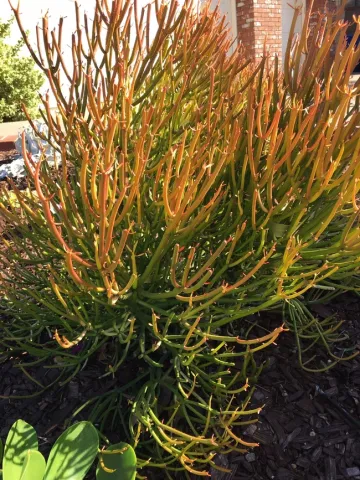
Firesticks
By Leslie Stevens UCCE Master Gardener
Euphorbia tirucalli ‘Rosea'
Planting areas: Sunset Zones 15, 16 and 17. Prefers frost-free areas, but tolerates short periods of cold temperatures down to 30 degrees Fahrenheit. Provide protective covering if colder temperatures are longer lasting.
Size: Narrow, upright small shrub to 6-to-8 feet tall
Bloom season: Tiny flowers are barely discernable and considered insignificant
Exposure: Full sun or partial sun
Pruning needs: Occasional trimming to remove dry or damaged stems
Water needs: Drought tolerant. Requires infrequent watering and well-drained soil to avoid rot.
Snapshot:
Fire Sticks draw attention to any garden where it resides. This wildly popular succulent sends up pencil-sized stems in brilliant shades of yellow, orange, green and red. There's nothing shy about it.
But for all its showiness, Fire Sticks aren't fussy. As long as they have plenty of sunshine and aren't water logged, they'll reward you with years of beauty and admiration.
They also play well with others. With its multitude of colors, Fire Sticks contrast nicely with the blue-greys of agaves and bronze and copper carex tones. Fire Stick's colors deepen toward more red in winter and lighten toward yellow in summer.
This easy-care plant isn't troubled by most pests and diseases, resists deer and rabbits and is salt tolerant.
Fire Sticks belong to the Euphorbia family of plants that includes about 2,000 species, including the better-known poinsettia. As with all Euphorbias, Fire Sticks exude a milky white sap that irritates skin and can be toxic if ingested. It's recommended to wear gloves when working with this plant. Also avoid planting in areas frequented by young children and pets.
###

